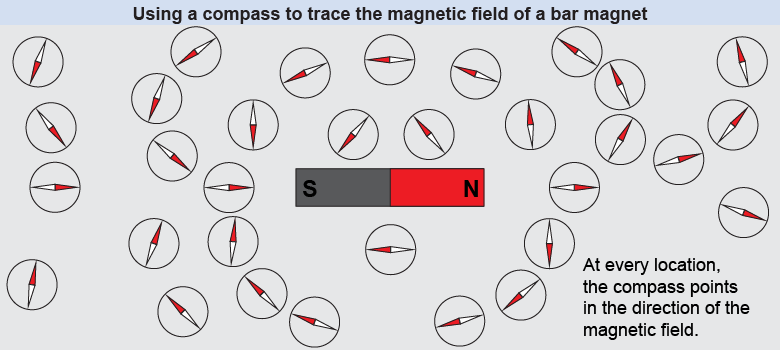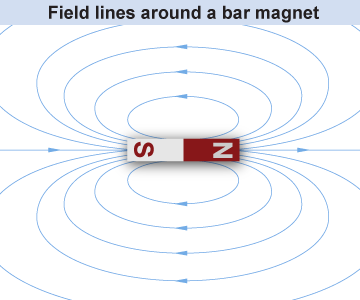|
The magnetic field describes the strength and direction of magnetic forces around a magnet. A compass needle is a magnet that is mounted so that it can spin freely. Compasses are sensitive detectors for magnetic fields. The diagram below shows how the needle of a compass changes at different points around a bar magnet. 
|

|
At every location we place a compass, its orientation tells us the direction of the magnetic force. The red end of a compass needle is typically the needle’s north magnetic pole. The compasses in the diagram above show that the compass needle’s north pole is attracted near the south pole of the bar magnet and repelled near the north pole of the bar magnet. 
|
 A magnetic field drawing uses lines and arrows to represent the force exerted on the north magnetic pole of a test magnet. In a drawing of the field around a bar magnet, the arrows point toward the south pole of the bar magnet and away from the north pole. These four rules apply to interpreting or making magnetic field diagrams:
A magnetic field drawing uses lines and arrows to represent the force exerted on the north magnetic pole of a test magnet. In a drawing of the field around a bar magnet, the arrows point toward the south pole of the bar magnet and away from the north pole. These four rules apply to interpreting or making magnetic field diagrams: - Magnetic field lines point into south poles and out of north poles.
- The closer the field lines are, the stronger will be the magnetic force.
- Field lines never cross.
- Field lines always make closed loops (but the portion of the loop inside the magnetic source may not be pictured).

|
The SI unit for magnetic field B is the tesla (T). A field of 1 T is very strong! As you will learn on the next two pages, the Earth’s magnetic field near the equator has a strength of around 3×10−5 T or 30 μT. The powerful magnets in a magnetic resonance imaging machine can have a field strength of 1 T (or so). 
|
Which pole of a magnet do magnetic field lines point toward?
 |
Magnetic field lines have arrows that point from magnetic north poles toward magnetic south poles. 
|

